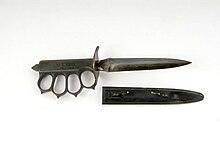Brass knuckles
A brass knuckles is a hand weapon that consists of a handle through which the fingers of the fist are inserted. Brass knuckles generally fall under the heading of striking weapons because they do not penetrate the body when they are used. If they are equipped with longer spikes or blades, they also fall under the cutting weapon , as they penetrate the body when used.
description
A brass knuckle is made of metal , wood , horn or plastics such as plexiglass. Brass knuckles are used in combat to strengthen the fist by concentrating the force of the punch on a harder and smaller contact area. When the blow is targeted, this leads to greater damage to tissue and affected bones . The extended and rounded grip of the palm also distributes the opposing forces that would otherwise mainly be absorbed by the attacker's fingers over a larger area in the attacker's fist, which reduces the risk of injury. To increase the potential for injury, the outside of the knuckle- box can be provided with rivets , have attached tips or be reinforced in the ankle area. Brass knuckles are relatively small and easy to hide in clothing.
Brass knuckles were and are used since the time of the indigenous peoples . There are different variants: Brass knuckles were made of metal, wood or of intertwined and stiffened cords in which animal teeth were attached.
history
Brass knuckles or brass knuckles have been common around the world since ancient times. In India they were used in the Vajra mushti fighting technique , they have been handed down from Manasollasa since the 12th century . The Nihang warrior caste of the Sikhs used a variant of brass knuckles with the Sher Panja in the 18th century. During the Civil War (1861-1865) brass knuckles made of cast iron, brass, lead and wood were common in the United States. Soldiers bought cast iron or brass ones. If they could not or did not want to afford them, they carved some out of wood or cast brass knuckles using the sand molding process from melted lead bullets.
At the end of the 19th century, the handles of various pistols were expanded to include the function of a striking weapon, such as For example, the Apache revolver, popular among French criminals in the late 19th to early 20th centuries . During the First World War , the US Army issued two different trench knives with brass knuckles, the US Model 1917 and the US Model 1918 Mark I. Brass knuckles and brass knuckles were also made in England at the time and were privately purchased by British soldiers. Up until World War II, brass knuckles and brass knuckles were quite popular with both American and British soldiers. The 1918 model trench knives were reissued to American paratroopers. British commandos even had their own "Death's Head" brass knives with a skull-shaped brass handle.
A notable brass knuckle knife that is still in use is the Cuchillo de Paracaidista, which was given out to Argentine paratroopers. Current models have an emergency blade in the guard (cross guard ).
Legal
Brass knuckles are in Germany ( Section 2, Paragraph 3 in conjunction with Annex 2, Section 1, No. 1.3.2 WaffG ), in Austria (Section 17, Paragraph 1, Item 6, WaffG ) and in Switzerland (Art. 4, Paragraph. 1 let. D and Art. 5 para. 1 let. D WG ).
See also
Web links
- Bronze brass knuckles from the 17th century in the holdings of the Västmanlands läns museum , Sweden
Individual evidence
- ^ H. Gordon Frost: Blades and barrels: six centuries of combination weapons . Walloon, El Paso, TX 1972, OCLC 1106930 (English).
- ^ Complete legal regulation for the Weapons Act 1996. In: Weapons Act (Austria) . July 1, 1997, accessed on March 11, 2014 : "Section 17. (1) It is prohibited to acquire, import, possess, and carry [...] those under the designation" brass knuckles "," killer "and "Steel rods" known cutting weapons. "
- ↑ SR 514.54 Federal Act on Weapons, Weapon Accessories and Ammunition, Articles 4 and 5 Law Section of the Swiss Federal Chancellery , January 1, 2013, accessed on March 11, 2014 : “Weapons are: [...] devices that are intended for this purpose To injure people, namely brass knuckles, batons, batons, throwing stars and slings; "


